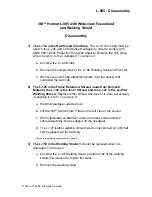
2
The handlebar, the part you hold with your hands when riding a bicycle, is
primarily responsible for your ability to steer and control the bike. In addition, the
handlebar works with the seat to define your posture on the bike, adding comfort
and efficiency to your cycling. The handlebar is connected to the bike by the stem.
This section explains how to inspect, adjust, and install your handlebar and stem.
Inspect your handlebar regularly
As with anything mechanical, every part of a bicycle has a limited useful life
due to wear, stress, and fatigue. Fatigue refers to a low-stress force that, when
repeated over a large number of cycles, can cause a material to fail or break.
The length of the life of a part varies according to its design, materials, use, and
maintenance. Although lighter parts may, in some cases, have a longer life than
heavier ones, it should be expected that light weight, high performance parts
require better care and more frequent inspections.
Regularly inspect your handlebar for signs of fatigue stress: dents, cracks,
scratches, deformation, or discoloration. Large forces can accelerate the fatigue
of a material. As an example, a crash may add a great deal of extra stress to your
bike. If you choose to jump your bicycle, use it for stunts, or ride it after a crash,
carefully inspect your handlebar for signs of fatigue before and after each ride.
If you are unsure of the safety of your Bontrager Carbon Aerobar, do not ride
the bicycle; take the bicycle to your dealer for adjustments. Even if you perform
regular inspections, be aware that if you exceed the limit of strength of a given
part, it will fail.
Unlike metal parts, carbon composite parts that have been damaged may not
bend, bulge or deform; a damaged part may appear to be normal to a cursory
glance. After any high force load, like a crash, or other impact to your bicycle,
thoroughly inspect all the parts of your bike, and use the following procedures
to inspect carbon composite parts.
• Check for scratches, gouges, or other surface problems.
• Check the part for loss of rigidity.
• Check the part for delamination.
Once a month
make sure the stem is in alignment with the front
Once a month
Once a month
wheel. Test the stem connection to the fork by attempting to turn the
handlebar from side to side with the front wheel locked between your
knees (Figure 2). Test the security of the handlebar by attempting to
rotate it in the stem. Make sure that no cables are stretched or pinched
by rotating the handlebar.
Check that all bolts are tight. Remove the nut from the bolt or
axle, clean the threads thoroughly, and apply a thread-locking
compound (Loctite 242 is excellent). Tighten these bolts until the
part is secure, but do not exceed the listed maximum torque:
• Aero extension clamp bolts: 60 lb•in (6.8 Nm)
• Elbow pad mounting bolts: 45 lb•in (5 Nm)
• Stem clamp bolts:
The correct tightness varies according to the
type of stem on your bike. Check your bicycle owner's manual for
these specifications. If you are unsure how to tighten these bolts,
these specifications. If you are unsure how to tighten these bolts,
consult your dealer.
Figure 2 Function test the
Figure 2 Function test the
handlebar and stem
handlebar and stem
WARNING
A damaged carbon fiber part can fail suddenly, causing
A damaged carbon fiber part can fail suddenly, causing
serious injury or death. Inspect a carbon fiber part for
serious injury or death. Inspect a carbon fiber part for
damage frequently. If you suspect a carbon fiber part is
damage frequently. If you suspect a carbon fiber part is
damaged, replace the part before riding, or take the bike to
damaged, replace the part before riding, or take the bike to
your dealer for service.
your dealer for service.
your dealer for service.
your dealer for service.























